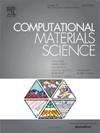High-throughput screening of ternary and quaternary chalcogenide semiconductors for photovoltaics
IF 3.1
3区 材料科学
Q2 MATERIALS SCIENCE, MULTIDISCIPLINARY
引用次数: 0
Abstract
Composition engineering offers a promising approach to discover new semiconductors with attractive optoelectronic properties. Screening based on high-throughput atomistic simulations provides a way to perform multi-objective optimization across a combinatorial compositional space. In this study, we used density functional theory (DFT) to explore the chemical space of ternary ABX2 and quaternary A2BCX4 chalcogenide semiconductors with X {S, Se, Te}, focusing on their thermodynamic stability, optoelectronic properties, and defect behavior. The A2BCX4 chemical space was defined as A {Na, K, Rb, Cs, Cu, Ag}, B {Mg, Ca, Sr, Ba, Zn, Cd}, and C {Sn, Ge}, while the ABX2 chemical space was defined as A {Na, K, Rb, Cs, Cu, Ag} and B {Al, Ga, In}. Each composition in either space was simulated using the Kesterite-type ordering as well as the Stannite-type ordering. For a total of 540 compounds, we performed geometry optimization, electronic structure, and optical absorption calculations using the GGA-PBEsol functional followed by the hybrid HSE06 functional with spin–orbit coupling (SOC), to determine formation and decomposition energies, bandgap, and spectroscopic limited maximum efficiency (SLME). Based on the HSE06+SOC computations, 45 compounds were found to be stable against decomposition and showed SLME 30%, suggesting high potential as single-junction solar cell absorbers. Although the Kesterite ordering is generally more stable than Stannite, the latter shows narrower bandgaps which are more suitable for solar absorption. We performed detailed point defect calculations on two selected candidates and found that they may be prone to harmful anti-site substitutional defects, which is a common issue in ternary and quaternary chalcogenides. We believe that further composition optimization via alloying at the cation or anion sites, and doping with suitable species, will help make the compounds more defect-tolerant, and our dataset provides the impetus for future studies.

求助全文
约1分钟内获得全文
求助全文
来源期刊

Computational Materials Science
工程技术-材料科学:综合
CiteScore
6.50
自引率
6.10%
发文量
665
审稿时长
26 days
期刊介绍:
The goal of Computational Materials Science is to report on results that provide new or unique insights into, or significantly expand our understanding of, the properties of materials or phenomena associated with their design, synthesis, processing, characterization, and utilization. To be relevant to the journal, the results should be applied or applicable to specific material systems that are discussed within the submission.
 求助内容:
求助内容: 应助结果提醒方式:
应助结果提醒方式:


